Although my blog posts are typically about topics related to healthy life balance, managing priorities, and getting organized, I feel compelled to write about something indirectly related that can have a life-changing effect on your future and the future of your kids and grandkids. Deadly forms of skin cancer are preventable, and early prevention and detection can save your life. I’m on a crusade to ban the tan. Keep reading to find out why.
Having grown up in Phoenix – the “Valley of the Sun” – I used to enjoy about 300 days a year of full sun. Back when I was a child, there was not much public knowledge available about the detrimental effects of sun exposure to the skin. I used to lay in the sun in my swim suit in our back yard and bake my skin so I could get a nice tan – something that was the “in” thing to have. I am very fair-skinned, so my skin burned easily without any sunscreen to protect it.
This past week, two friends had skin cancers removed. I recently had an actinic keratosis removed from my face – a pre-cancerous growth caused by damage from exposure to ultraviolet (UV) radiation. According to my dermatologist, most of my current skin issues are a direct result of sun exposure I received by the time I was in my teens. The good news is that skin cancer is preventable, and early detection can save your life.
An ounce of prevention is worth a pound of cure!

Sunscreen isn’t just for preventing sunburns. The sun’s rays are responsible for much of the wrinkling and brown “age” spots that appear on our skin over time, especially for people with light skin. Fortunately, a good broad-spectrum sunscreen will protect you.
Not only is sunscreen essential to good skin health, but it’s important to be sure that all exposed areas of skin are covered – including your lips, ears, hands, feet, and back of the 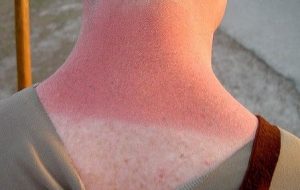 neck, which are areas that are easily forgotten.
neck, which are areas that are easily forgotten.
In my teens, I recall vacationing in Mexico and falling asleep on the beach in the middle of the day. When I awoke, my eyelids were so badly burned and swollen that I could hardly open them. I also had a blistering sunburn on my feet and on the part line of my hair, making it painful to wear shoes and brush my hair for the next week. Had I worn a hat and some sunscreen, I could have prevented this painful sunburn.
Those blistering sunburns of my youth have increased my lifetime risk of the most serious form of skin cancer – melanoma.
Facts About the Sun

Although we are headed into the winter months in the US, it’s important to continue using UV sun protection in all climates. If you are a skier, snowboarder, or mountain hiker, note that higher elevation exposes your skin to more UV radiation. The UV rays also reflect off the snow and are stronger than you think! A ski vacation with a sunburn is no fun, so protect your skin while enjoying nature during the winter months.
If you escape the winter cold by going on a tropical vacation, be sure you remember to pack your sunscreen, sun hat, and an SPF lip balm.
 Also remember that you can still get sunburned on a cloudy day. Clouds filter out sunlight, but not the bad UV rays that cause aging and cancer. The Skin Cancer Foundation says that clouds block as little as 20% of UV rays, so on a cloudy day you’re still exposed to 80% of the sun’s harmful rays.
Also remember that you can still get sunburned on a cloudy day. Clouds filter out sunlight, but not the bad UV rays that cause aging and cancer. The Skin Cancer Foundation says that clouds block as little as 20% of UV rays, so on a cloudy day you’re still exposed to 80% of the sun’s harmful rays.
 Although many adults have already received harmful UV damage from their early childhood and teen years, your children and grandchildren can still be protected from receiving damage to their skin. Be a responsible adult and do your part to protect children and teens from the harmful year-around effects of UV rays.
Although many adults have already received harmful UV damage from their early childhood and teen years, your children and grandchildren can still be protected from receiving damage to their skin. Be a responsible adult and do your part to protect children and teens from the harmful year-around effects of UV rays.
Skin Cancer Facts
Skin cancer is the most common of all human cancers. Despite increased awareness that it is most frequently caused by the preventable but harmful effects of ultraviolet (UV) light, one in five Americans will develop skin cancer in their lifetime.
Basal cell carcinoma (BCC) is the most common form of skin cancer and squamous cell carcinoma (SCC) is the second most common. More than 5.4 million cases of basal cell and squamous cell are diagnosed in the U.S. each year, resulting in less than 2,000 deaths. These types of skin cancer are not as dangerous as melanoma and rarely spread to other parts of the body like melanoma can. BCC and SCC typically grow over a period of months to years and appear on skin that is most frequently exposed to the sun.
It’s important to note that people taking immunosuppressant medications – such as those who have had kidney, heart or liver transplants – are at very high risk for squamous cell carcinoma (SSC). In these individuals, SCC is much more likely to spread because the immune system has been suppressed. Therefore, transplant patients need to be even more vigilant about protecting their skin from the sun’s harmful UV rays.
The risk of melanoma increases as people age. The average age of people diagnosed with melanoma is 63. That being said, melanoma is not uncommon even among those under the age of 30. Because melanoma is the deadliest form of skin cancer if not detected early, it’s important to know the warning signs.
Warning Signs to Watch For
The American Academy of Dermatologists recommends using the ABCDE of Melanoma Detection.
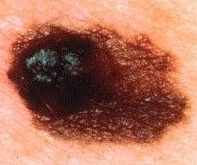 A is for Asymmetry – Melanoma lesions are often not symmetrical in shape. Benign moles are usually symmetrical, meaning that if a line was drawn through the middle of the mole, the two sides would match up.
A is for Asymmetry – Melanoma lesions are often not symmetrical in shape. Benign moles are usually symmetrical, meaning that if a line was drawn through the middle of the mole, the two sides would match up.
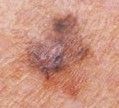 B is for Border – Typically, non-cancerous moles have smooth, even borders. Melanoma lesions usually have irregular borders that are difficult to define.
B is for Border – Typically, non-cancerous moles have smooth, even borders. Melanoma lesions usually have irregular borders that are difficult to define.
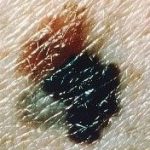 C is for Color – The presence of more than one color (blue, black, brown, tan, etc.) or the uneven distribution of color can sometimes be a warning sign of melanoma. Benign moles are usually a single shade of brown or tan.
C is for Color – The presence of more than one color (blue, black, brown, tan, etc.) or the uneven distribution of color can sometimes be a warning sign of melanoma. Benign moles are usually a single shade of brown or tan.
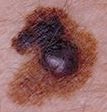 E is for Evolving or Elevated – Look for moles raised above the surface or with an uneven surface. Also look for moles that are changing in size, shape or color. The evolution of your mole(s) is the most important factor to consider when diagnosing a melanoma. Knowing what is normal for you could save your life.
E is for Evolving or Elevated – Look for moles raised above the surface or with an uneven surface. Also look for moles that are changing in size, shape or color. The evolution of your mole(s) is the most important factor to consider when diagnosing a melanoma. Knowing what is normal for you could save your life.
Regular head-to-toe checks are essential!
Because we all receive sun exposure — and sun damage is known to cause skin cancer — it’s important to have all of your skin checked out regularly from head to toe. Also, note that not all melanomas fall within the ABCDE parameters, so regular visits to your dermatologist can catch any potential issues early.
If you have concerns about anything on your skin, get it checked out right away. It is not something to “wait and see” or to put off.
Remember that skin cancer is treatable when detected early and can be deadly when ignored…so practice preventive measures and stay alert. Your life and the lives of your loved ones may depend on it.
Additional Resources:
- Blog: Balance Your Life: Environment #2 – Body
- For more information about skin cancer, visit SkinCancer.org or Skin Cancer Guide

Life Architect – Creating Blueprints for Purposeful & Productive Lives
Kathy@OrgCoach.net www.OrgCoach.net Follow me on Facebook






Thanks for the important reminder Kathy. I had skin cancer about 10 years ago, and I’m also on the “ban the tan” bandwagon!
Good for you for being careful about your exposure, Laura!
A LinkedIn reader posted a comment related to this article, and I thought I’d share her comment here.
COMMENT: You need Vitamin D naturally! Just limit the hours between noon and 3 PM
KATHY’S RESPONSE: Here’s a good article about protecting your skin AND getting adequate Vitamin D: https://www.skincancer.org/healthy-lifestyle/vitamin-d/damage
That is great info…Thank you dear Kathy…..